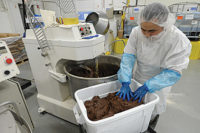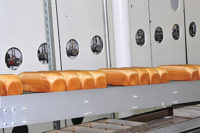We toured Nonni’s Foods 45,000-sq.-ft. biscotti production facility in Ferndale, N.Y., one of the company’s four bakeries across North America. Outfitted with one large processing line and multiple packaging lines downstream, the plant expertly manufactures Nonni’s original long-stick biscotti at rates of 1,600-1,700 lb. an hour.
On the day Snack Food & Wholesale Bakery visited Nonni’s Foods LLC’s biscotti production facility in Ferndale, N.Y., we were welcomed by the warm, buttery aroma of anise, almonds and white chocolate. Nestled in a hilly area south of New York’s Catskill Mountains, the spanking clean facility produces the company’s long-stick Original Biscotti in all eight flavors—Limone, Salted Caramel Biscotti, Toffee Almond, Triple Milk Chocolate, Decadence, Turtle Pecan, Originali and Cioccolati—as well as Mini Biscotti for clubstore sales in 2.2-lb. clear plastic canisters.
Sitting on 75 areas, the 45,000-sq.-ft. plant was originally owned by a beer distributorship, recalls plant manager Ed McDermott, who worked with a biscotti maker at the plant prior to the plant’s acquisition by Nonni’s Foods. “The layout was perfect for our needs because it was a really long, narrow building, so we could easily fit our 110-ft.-long tunnel oven in there,” he explains. “Beer companies have long rooms where tractor trailers come in on the side and get washed. The warehouse was already air-conditioned (for the beer), so that worked well for us, considering that we work with chocolate. It also had a refrigerator room, which is perfect for storing our butter, eggs, flavorings and nuts.”
Says Nonni’s Foods chairman and CEO David Bere, “We’ve had such great growth over the years that we went well beyond one facility and grew to have four scattered across [North America]. Two of our facilities make the original Nonni’s long-stick biscotti: Ferndale, N.Y.; and Tulsa, Okla.”
Ferndale is the largest of the four plants, with the most sophisticated equipment. The company began operating there in late 2005. Says Peter Hetrick, executive vice president, sales and marketing, “Ferndale is a state-of-the-art facility. The plant provides great consistency and control and has a lot of automation. Ferndale was our second production facility after we got the one in Tulsa. A year and a half ago, we got the THINaddictives plant in Montreal and in January of this year came the La Dolce Vita business and plant in Glendale, Ariz. The Ferndale plant has only one processing line, but it’s a big one.”
Large-volume output
The complex biscotti line requires 28 people per shift to operate all of its stations. “In total, there are about 90 employees at this plant, including the front office, quality control, shipping, sanitation and maintenance,” McDermott explains. “We have a lot of volume, so we usually run one SKU all day and all night, which saves on changeovers. We can change over perhaps twice a day, depending the product, the schedule and how busy we are, but try to keep it down to once at the very most. Anything more requires a thorough, 30-minute cleanup, adjustments of the speed of the extruder and the cutter and a few other equipment adjustments.”
Several pieces of new production equipment have been installed over the years as needed, including a recently purchased, proprietary extruder and ultrasonic cutting system, McDermott says. “I’ve seen a lot of things updated,” he adds. “When Nonni’s first started up here, we began working with real chocolate and had to install a tempering unit, so we got one. We also added new cartoners and four additional biscotti wrappers (we started with one) and are looking at other new things like robotic loaders. There’s a lot of potential at this plant. Nonni’s strives for quality and consistency—we have a passion for what we do, so it’s nice that we can make these equipment investments.”
Producing biscotti at rates of an amazing 1,600-1,700 lb. an hour in two daily eight-hour shifts, five days a week most of the year, the plant has many similarities to the facility in Tulsa, and much of the same kind of equipment, McDermott says. “Nonni’s Foods was growing, and more and more product was being shipped into supermarkets, so we had to have more capacity,” he explains. “Acquiring this plant really worked out well. Today, depending on the season, we can generate anywhere from 150,000-250,000 lb. a week.”
During the fall, however, McDermott says, production accelerates to 24 hours a day five days a week, and in certain situations, six days. “So we keep pretty busy during the months leading up to the holidays,” he says. “At that time, we’ll go to three shifts and when we really get busy, we can produce 800,000 lb. of product a week. The busy season really starts in August.”
On the day of Snack Food & Wholesale Bakery’s visit, the line was making Original, a blend of almonds, walnuts and a hint of anise. The smell of anise wafted through the whole plant and parking lot. Processing is in-line with packaging, though not all in the same room. Production begins with “only the finest ingredients” o provide a great, distinctive taste, McDermott says. Being twice-baked, hence the name (the word biscotti in Italian means twice-baked), the cookies have a shelf life of from six to nine months, depending on the variety.
Mixing, extruding, baking
The flour is automatically scaled and pumped to a spiral batch mixer via forced air from a recently purchased, indoor flour silo that holds a maximum of 100,000 lb. Operators add other raw ingredients, such as sugar, baking powder, nuts and spices, from bulk 55-lb. bags. Eggs are contained in 2,000-lb. intermediate bulk containers. Each batch of biscotti dough is about 1,200 lb. and takes about 30 minutes to complete.
“We have two mixers and use them one at a time,” McDermott says. “The smaller mixer, which is our original machine, produces 600-lb. batches. If we have a small production run or a low-volume item, we use that
system. We try to make at least one major improvement to the plant each year, and the recent addition of the indoor flour silo was a great investment. It improves efficiencies by saving 2.5 cents per lb. on flour. That means, through the year, we’ll save in excess of $100,000.”
When the batch is ready, operators use a forklift to remove the bowl from the mixer and load the large bowl of dough into a trough. The trough is forklifted over to an extruder and raised over its empty hopper to release the dough into the extruder, which rolls and thins out the dough as it emerges in continuous rows on 10 lanes of a conveyor. A topping applicator deposits sliced and ground almonds on the top surface of the rows, followed by an egg wash that keeps the nuts intact and also provides a nice golden-brown color and sheen.
Next, the lanes of dough convey to a 110-ft.-long multizone tunnel oven, where the biscotti is baked for the first time at temperatures of approximately 400 deg. F (depending on the product) for 17 minutes (again depending on the product). Baking reduces the moisture in the dough from 22% to about 12%. After baking, the golden rows of biscotti slowly make their way down to a specialty ultrasonic cutting system, which cuts them into thin individual pieces. Each regular-size biscotti measures 5¼ in. long and is just less than 1 in. wide. The Mini Biscotti are approximately half that size.
The cut cookies then cool on their conveyor ride, and make a sharp, 90-degree turn before being baked again in another multizone tunnel oven that decreases the moisture level to about 3-4%. “It’s important that we watch the moisture in the biscotti because it directly affects the product’s shelf life,” McDermott points out.
Then, the cut pieces bake in a second tunnel oven for about 12 min. at temperatures “in the low 300s,” to get the moisture down to about 2%. With an exposed cut, both sides of the biscotti are exposed, so the moisture is reduced more rapidly. The biscotti exit on a wide belt and continue to cool before entering one of two cooling tunnels that bring them to a temperature of 85 deg. F before they convey out of the room and into the packaging area.
If the cookies require a bottom dip of chocolate (white, milk or dark), they would head over to the chocolate area and into an enrober before being cooled and wrapped. “Tempered chocolate is very sensitive,” McDermott explains. “So the temperature range of the product has to be 89-93 deg. F before we can add chocolate. Tempering chocolate can only be done within a 4-degree temperate range, so the biscotti has to cool down quite a bit before we can add the chocolate. If it’s too hot, the chocolate will just melt right off and bloom. Too cool, and it won’t work. So we must cool the product down before it goes through the tempered chocolate enrober.”
Wrapping, cartoning
The Original biscotti that we viewed bypasses the enrober and conveys into the packaging room. Inside, there are five flowrapping lines that each run about 150 individually wrapped packs/min. The Mini Biscotti are diverted to a proprietary canister-loading/lidding station where the 2.2-lb. containers receive a protective shrink band and are put through a shrink tunnel to secure the seal.
Meanwhile, the Original long-stick biscotti travel down a straightline conveyor that has a sensor to direct the product to a 90-deg. turn and into the proper branch-off lane leading to the five flowrappers. The flowrappers envelop the product in clear, two-color-printed film and cut the wraps before the treats move through a checkweigher and the first of two metal detectors. “The metal detectors are the main Hazard Analysis and Critical Control Point (HACCP) on the line,” says McDermott. “We are very concerned with food safety.”
A packaging operator then loads the wrapped biscotti into clear plastic trays in counts of eight, and the trays are automatically cartoned. The packages then enter the second metal detector to ensure that no contaminants go into the clear plastic trays or the cartons. Case-packing is next. A late-model, servo-controlled case packer with a built-in elevator collates six cartons at a time and layers them into corrugated shipping cases, later sealing the cases with hot-melt adhesive. As the cases eject from the system, they pass an ink-jet coder that prints their sides with a production code. Next, the cases are palletized by hand, and the finished loads are automatically stretch-wrapped and forklifted to the warehouse.
Universal procedures, standards
“We are very concerned with food safety,” McDermott reiterates. “We became certified in the Safe Quality Food (SQF) program as soon as we could, and right now, this plant is moving up to Level 3. SQF was a long process but it’s well worth the work.”
Also playing an important part in food safety is the Quality Control room, where Quality Assurance technicians frequently test product coming off the line and track each batch of product from the point where the dough is mixed, straight through to packaging. “Our QA techs record all of the lot numbers, keep track of the weights, check every ingredient coming into the facility and record everything, so that all of our procedures are documented,” McDermott says. There are also QA stations on the line that compare the product to prescribed weights, moisture, heights, widths and lengths as it makes its way from one station to another.
For every batch, various QC procedures are performed and all shipping labels, code dates and product weights are checked. “Each product has its own standard, so if something’s off a bit, the QC department determines that we need to adjust the weight by resetting some of the equipment,” the plant manager says. “So the QA techs follow each batch as it’s made and record all of its statistics for SQF. It’s a great program. It’s a lot of training, it’s time-consuming and costly, but we participated early on in the game.”
How do McDermott and the plant personnel manage to balance Nonni’s Foods’ high-volume production with speedy scheduling, food safety and the bottom line? “Demand is really growing, so communication is important,” he says. “That’s the good thing about our company. We currently have two plants doing the basically same thing, and all of our functions are documented and uniform plant-to-plant, so that everyone’s on the same page. We also have really talented Information Technology (IT) and customer service departments, and our scheduler is very flexible. A lot of our customers have a long track record with us, and the scheduler really helps us coordinate production and inventory efficiently, which alleviates backups. Plus, we don’t have to run six different items in one day.”
Oddly enough, unlike many other bakeries, the plant produces as little biscotti on a just-in-time basis as possible. “We try to ask for a two-week leadtime from the time orders are placed,” McDermott says.
People with a passion
In all of Nonni’s Foods’ factories, the lead people are quite passionate about what they do, Hetrick points out. “They’re really hands on and involved in how they bake product,” he says. “They don’t sit in an office; they get in there with the cookies and fine-tune everything.”
McDermott agrees: “I was always involved with hands-on, small companies. That’s the nice thing about Nonni’s. We get more input on how things are going on the line, the equipment and the product, and I’ve always enjoyed that. Nonni’s allows us to try things and experiment. If we try to do something new that works and makes sense, we do it. If we prove that it’ll save money, it’s fast-tracked. We are nimble and can turn things around quickly.”
That’s what Bere also says he loves about Nonni’s Foods. “The people are very passionate about what they do,” he explains. “There’s so much passion and expertise and they bring that to everything. Ferndale is a really see a good example of that.”













